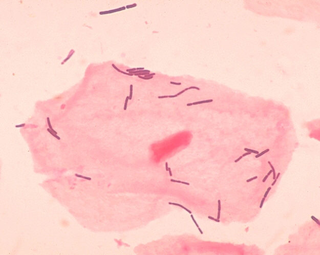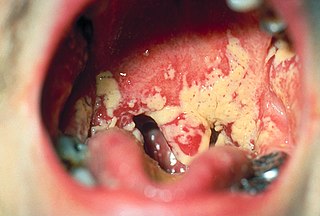Related Research Articles

Pseudomonadota is a major phylum of Gram-negative bacteria. Currently, they are considered the predominant phylum within the realm of bacteria. They are naturally found as pathogenic and free-living (non-parasitic) genera. The phylum comprises six classes Acidithiobacillia, Alphaproteobacteria, Betaproteobacteria, Gammaproteobacteria, Hydrogenophilia, and Zetaproteobacteria. The Pseudomonadota are widely diverse, with differences in morphology, metabolic processes, relevance to humans, and ecological influence.

Lactobacillus is a genus of gram-positive, aerotolerant anaerobes or microaerophilic, rod-shaped, non-spore-forming bacteria. Until 2020, the genus Lactobacillus comprised over 260 phylogenetically, ecologically, and metabolically diverse species; a taxonomic revision of the genus assigned lactobacilli to 25 genera.

The human microbiome is the aggregate of all microbiota that reside on or within human tissues and biofluids along with the corresponding anatomical sites in which they reside, including the gastrointestinal tract, skin, mammary glands, seminal fluid, uterus, ovarian follicles, lung, saliva, oral mucosa, conjunctiva, and the biliary tract. Types of human microbiota include bacteria, archaea, fungi, protists, and viruses. Though micro-animals can also live on the human body, they are typically excluded from this definition. In the context of genomics, the term human microbiome is sometimes used to refer to the collective genomes of resident microorganisms; however, the term human metagenome has the same meaning.
In medicine, the hygiene hypothesis states that early childhood exposure to particular microorganisms protects against allergies by properly tuning the immune system. In particular, a lack of such exposure is thought to lead to poor immune tolerance. The time period for exposure begins before birth and ends at school age.

Gut microbiota, gut microbiome, or gut flora are the microorganisms, including bacteria, archaea, fungi, and viruses, that live in the digestive tracts of animals. The gastrointestinal metagenome is the aggregate of all the genomes of the gut microbiota. The gut is the main location of the human microbiome. The gut microbiota has broad impacts, including effects on colonization, resistance to pathogens, maintaining the intestinal epithelium, metabolizing dietary and pharmaceutical compounds, controlling immune function, and even behavior through the gut–brain axis.

Bacteroides is a genus of Gram-negative, obligate anaerobic bacteria. Bacteroides species are non endospore–forming bacilli, and may be either motile or nonmotile, depending on the species. The DNA base composition is 40–48% GC. Unusual in bacterial organisms, Bacteroides membranes contain sphingolipids. They also contain meso-diaminopimelic acid in their peptidoglycan layer.
Dysbiosis is characterized by a disruption to the microbiome resulting in an imbalance in the microbiota, changes in their functional composition and metabolic activities, or a shift in their local distribution. For example, a part of the human microbiota such as the skin flora, gut flora, or vaginal flora, can become deranged (unbalanced), when normally dominating species become underrepresented and species that normally are outcompeted or contained increase to fill the void. Similar to the human gut microbiome, diverse microbes colonize the plant rhizosphere, and dysbiosis in the rhizosphere, can negatively impact plant health. Dysbiosis is most commonly reported as a condition in the gastrointestinal tract or plant rhizosphere.
Fusobacterium polymorphum is a subspecies strain of the anaerobic, Gram-negative bacterium, Fusobacterium nucleatum. Originally, it was isolated from the plaque samples of individuals diagnosed with periodontitis and has been phylogenetically identified as its own distinct sub-group, separate from its previously studied sister strains. Research studies have also linked this subspecies to human diseases, such as fatal sepsis and inflammatory periodontal disease.

Oral microbiology is the study of the microorganisms (microbiota) of the oral cavity and their interactions between oral microorganisms or with the host. The environment present in the human mouth is suited to the growth of characteristic microorganisms found there. It provides a source of water and nutrients, as well as a moderate temperature. Resident microbes of the mouth adhere to the teeth and gums to resist mechanical flushing from the mouth to stomach where acid-sensitive microbes are destroyed by hydrochloric acid.

Pathogenic bacteria are bacteria that can cause disease. This article focuses on the bacteria that are pathogenic to humans. Most species of bacteria are harmless and many are beneficial but others can cause infectious diseases. The number of these pathogenic species in humans is estimated to be fewer than a hundred. By contrast, several thousand species are part of the gut flora present in the digestive tract.

Long-term close-knit interactions between symbiotic microbes and their host can alter host immune system responses to other microorganisms, including pathogens, and are required to maintain proper homeostasis. The immune system is a host defense system consisting of anatomical physical barriers as well as physiological and cellular responses, which protect the host against harmful microorganisms while limiting host responses to harmless symbionts. Humans are home to 1013 to 1014 bacteria, roughly equivalent to the number of human cells, and while these bacteria can be pathogenic to their host most of them are mutually beneficial to both the host and bacteria.

Microbiota are the range of microorganisms that may be commensal, mutualistic, or pathogenic found in and on all multicellular organisms, including plants. Microbiota include bacteria, archaea, protists, fungi, and viruses, and have been found to be crucial for immunologic, hormonal, and metabolic homeostasis of their host.
In biology, a pathogen, in the oldest and broadest sense, is any organism or agent that can produce disease. A pathogen may also be referred to as an infectious agent, or simply a germ.
The host-pathogen interaction is defined as how microbes or viruses sustain themselves within host organisms on a molecular, cellular, organismal or population level. This term is most commonly used to refer to disease-causing microorganisms although they may not cause illness in all hosts. Because of this, the definition has been expanded to how known pathogens survive within their host, whether they cause disease or not.

The root microbiome is the dynamic community of microorganisms associated with plant roots. Because they are rich in a variety of carbon compounds, plant roots provide unique environments for a diverse assemblage of soil microorganisms, including bacteria, fungi, and archaea. The microbial communities inside the root and in the rhizosphere are distinct from each other, and from the microbial communities of bulk soil, although there is some overlap in species composition.

A microbiome is the community of microorganisms that can usually be found living together in any given habitat. It was defined more precisely in 1988 by Whipps et al. as "a characteristic microbial community occupying a reasonably well-defined habitat which has distinct physio-chemical properties. The term thus not only refers to the microorganisms involved but also encompasses their theatre of activity". In 2020, an international panel of experts published the outcome of their discussions on the definition of the microbiome. They proposed a definition of the microbiome based on a revival of the "compact, clear, and comprehensive description of the term" as originally provided by Whipps et al., but supplemented with two explanatory paragraphs, the first pronouncing the dynamic character of the microbiome, and the second clearly separating the term microbiota from the term microbiome.
Sarkis Mazmanian is an American medical microbiologist who has served as a professor at the California Institute of Technology since 2006. He is currently the Luis & Nelly Soux Professor of Microbiology in the Division of Biology and Biological Engineering, and a board member of Seed. Prior to this, Mazmanian was affiliated with Harvard Medical School and the University of Chicago. In 2012, Mazmanian was awarded a MacArthur Fellowship for his pioneering work on the human microbiome.
Hologenomics is the omics study of hologenomes. A hologenome is the whole set of genomes of a holobiont, an organism together with all co-habitating microbes, other life forms, and viruses. While the term hologenome originated from the hologenome theory of evolution, which postulates that natural selection occurs on the holobiont level, hologenomics uses an integrative framework to investigate interactions between the host and its associated species. Examples include gut microbe or viral genomes linked to human or animal genomes for host-microbe interaction research. Hologenomics approaches have also been used to explain genetic diversity in the microbial communities of marine sponges.

Bacteroides thetaiotaomicron is a Gram-negative, obligate anaerobic bacterium and a prominent member of the human gut microbiota, particularly within the large intestine. B. thetaiotaomicron belongs to the Bacteroides genus – a group that is known for its role in the complex microbial community of the gut microbiota. Its proteome, consisting of 4,779 members, includes a system for obtaining and breaking down dietary polysaccharides that would otherwise be difficult to digest for the human body.

Since the colonization of land by ancestral plant lineages 450 million years ago, plants and their associated microbes have been interacting with each other, forming an assemblage of species that is often referred to as a holobiont. Selective pressure acting on holobiont components has likely shaped plant-associated microbial communities and selected for host-adapted microorganisms that impact plant fitness. However, the high microbial densities detected on plant tissues, together with the fast generation time of microbes and their more ancient origin compared to their host, suggest that microbe-microbe interactions are also important selective forces sculpting complex microbial assemblages in the phyllosphere, rhizosphere, and plant endosphere compartments.
References
- 1 2 3 4 Jochum, Lara; Stecher, Bärbel (October 2020). "Label or Concept – What Is a Pathobiont?". Trends in Microbiology. 28 (10): 789–792. doi: 10.1016/j.tim.2020.04.011 . ISSN 0966-842X. PMID 32376073. S2CID 218532205.
- ↑ Chow, Janet; Tang, Haiqing; Mazmanian, Sarkis K. (August 2011). "Pathobionts of the Gastrointestinal Microbiota and Inflammatory Disease". Current Opinion in Immunology. 23 (4): 473–480. doi:10.1016/j.coi.2011.07.010. ISSN 0952-7915. PMC 3426444 . PMID 21856139.
- ↑ Mazmanian, Sarkis K.; Round, June L.; Kasper, Dennis L. (May 2008). "A microbial symbiosis factor prevents intestinal inflammatory disease". Nature. 453 (7195): 620–625. Bibcode:2008Natur.453..620M. doi:10.1038/nature07008. ISSN 0028-0836. PMID 18509436. S2CID 205213521.
- ↑ Casadevall, Arturo (February 22, 2017). Alspaugh, J. Andrew (ed.). "The Pathogenic Potential of a Microbe". mSphere. 2 (1). doi:10.1128/mSphere.00015-17. ISSN 2379-5042. PMC 5322344 . PMID 28251180.